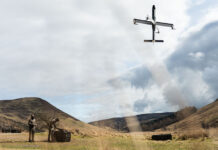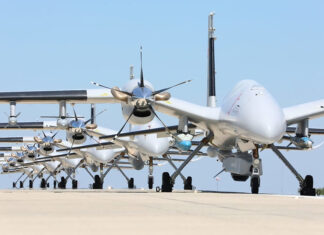Raytheon is introducing a lighter exoskeleton system offering stronger system with more endurance over the company’s first generation exoskeleton developed by Sarcos in 2002. Sarcos became part of Raytheon in 2007. The new ‘second generation’ XOS 2 system is built from a combination of structures, sensors, actuators and controllers, and it is powered by high pressure (3,000psi) hydraulics. XOS 2 is lighter, stronger and faster than its predecessor, yet it uses 50 percent less power, and its new design makes it more resistant to the environment.

“XOS 1 was essentially a proof of concept. With XOS 2, we targeted power consumption and looked for ways to use the hydraulic energy more efficiently. That’s resulted in us being able to add capabilities while significantly reducing power consumption.” According to Dr. Fraser Smith, Vice President of Operations at Raytheon Sarcos, the target is 20% of what the original XOS used, therefore enabling it to operate in ‘non tethered’ mode. To eliminate the potential risk associated with lithium ion rechargeable batteries, XOS2 uses a small internal-combustion engine to charge the batteries maintain hydraulic pressure. Smith hopes a XOS2 type system could be fielded within five years. “Getting exoskeletons deployed is inevitable. They are desperately needed, and I believe the military looks at them as viable solutions to a number of current issues they are trying to address. ” Smith said.

According to Raytheon, XOS 2 does the lifting for its operator, reducing both strain and exertion, enabling one operator to do the work of two to three soldiers. For example, the wearer can lift weights up to 200 lbs repetitively without tiring. Without the use of augmentation systems, repetitive heavy lifting can lead to injuries, orthopedic injuries in particular. The suite is flexible and responsive enough to enable the wearer to walk at a speed of 3.5 mph.
The exoskeleton is essentially a wearable robotics suit, designed to help with the many logistics challenges faced by the military both in and out of theater. The Army is hopeful that by deploying exoskeletons the number of support personnel in theater could be reduced. Raytheon hopes that tethered XOS type systems could be fielded with logistical support role within five years.
Raytheon unveiled the new suite at its Salt Lake City research facility. Representatives from Paramount Pictures, including the actor Clark Gregg (aka Agent Phil Coulson of the Marvel Movie franchise) were in attendance to capture footage of new robotic suite, to include in a video that’s being produced to support the release of Iron Man 2 on DVD and Blu ray.



















